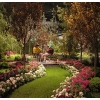|
 Floral design is the art of using plant materials and
flowers to create a pleasing and balanced composition inside or outside the
building. Currently popular floristry is one of the trends in floral
design. The evidence of refined
floristry is found as far back as the culture of Ancient Egypt. Floral design is the art of using plant materials and
flowers to create a pleasing and balanced composition inside or outside the
building. Currently popular floristry is one of the trends in floral
design. The evidence of refined
floristry is found as far back as the culture of Ancient Egypt.
You should remember that floral design is not limited to
decorating living spaces with flowers and plants; it also takes into
consideration all the features of the area, from design to its architectural structure,
so that the plants are smoothly incorporated into the environment. No wonder floral
and landscape design is often called gardening, raised to an art form.
The history of floral and landscape extends across at least
4,000 years of human civilization. Egyptian tomb paintings of the 1500s BC are
some of the earliest physical evidence of ornamental horticulture and landscape
design; they depict lotus ponds surrounded by symmetrical rows of acacias and
palms. Another ancient gardening tradition is of Persia: Darius the Great was
said to have had a ‘paradise garden' and the Hanging Gardens of Babylon were
renowned as a Wonder of the World. Today, floral design is the most affordable
and effective way of ‘dressing up' the living spaces, as the purchase of new
furniture, renovation or rebuilding is not always possible (for financial
reasons among others), but you can give a room a completely new look by
strategically placing some plants and changing it almost beyond recognition.
Floral design started small, with a bouquet in a vase and
some flowers beds near the house, but gradually evolved into an art form. In
the middle ages, women were required not only to be good housekeepers but also
to be versed in horticulture and landscaping basics. In medieval Europe, monasteries
carried on a tradition of garden design and intense horticultural techniques.
Rather than any one particular horticultural technique employed, it is the
variety of different purposes the monasteries had for their gardens that serves
as testament to their sophistication. As for gardening practices, records are
limited, and there are no extant monastic gardens that are entirely true to
original form. Generally, monastic garden types consisted of kitchen gardens,
infirmary gardens, cemetery orchards, cloister garths and vineyards. Individual
monasteries might also have had a ‘green court', a plot of grass and trees
where horses could graze, as well as a cellarer's garden or private gardens for
monks who held specific posts within the monastery.
There is evidence that first winter garden was built in 1240
in Cologne specifically to welcome the King of Holland; it was a small building
with the green trees and blossoming plants - mind that the King's visit occurred
in winter. However, regular winter gardens emerged in 17th to 19th centuries
when European nobility would construct large conservatories that would house
tropical and subtropical plants and would act as an extension of their living
space. Many of these would be attached to their main palaces. Winter gardens
were not just restricted to private residence; many were built for the greater
public.
Today, floral and landscape design has acquired special
significance. In addition to beautifully transforming any interior, plants also
make air fresher and improve the environment which is highly valuable in the world
of plastic and metal and artificial materials. And do not forget about the
aesthetic component: floral design allows feeling the breath of nature in our
highly industrialized world.
With the ever-growing interest in the natural world and
flowers, the floral industry continues to grow. The increase in educational
institutes providing training in floral design has expanded to many state
universities as well as certified design schools worldwide. Departments of
landscape architecture are located within university schools of architecture or
environmental design, with undergraduate and graduate degrees offered.
Specialties and 'minors' are available, such as in horticultural botany,
horticulture, natural resources, landscape engineering, construction
management, fine and applied arts, and landscape design history.
Other routes of training are through informal
apprenticeships with practicing landscape designers, landscape architects,
landscape contractors, gardeners, nurseries and garden centers, and docent
programs at botanical and public gardens. Since the landscape designer title
does not have college degree or licensing requirements to be used, there is a
very wide range of sophistication, aesthetic talent, technical expertise, and
specialty strengths to be responsibly matched with specific client and project
requirements.
|